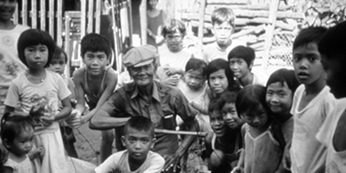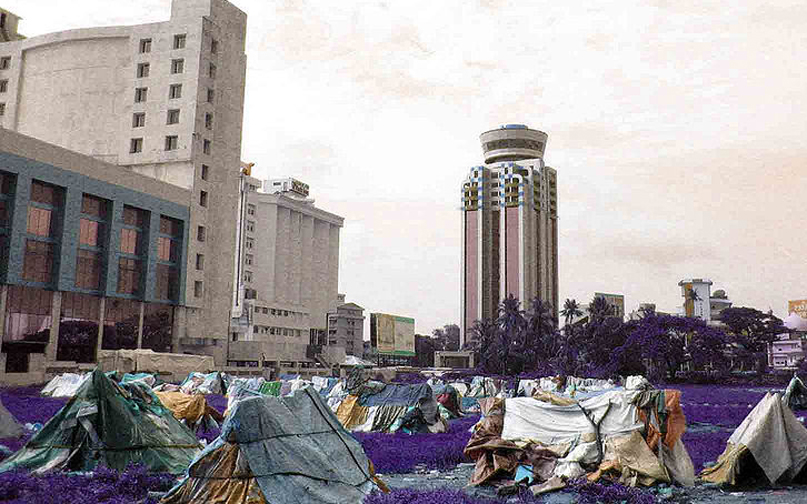Urban Leadership Foundation
A hub for leadership training among the world's 1.4 billion slum-dwellers
Creating Alternative Post Modern Models in Mission to the Marginalized
"If it dies, it bears much fruit" - Jesus
Case Studies: Some Works & Their Genesis
"Of the best of leaders, when the work is done, the people will say, "We did it ourselves!"
Korean leaders have been asking me, as an alternative to power-based structures that they have ended up leading, to document how a prophetic/apostolic ministry can operate without building a large organizational and hierarchical structure. American funders are confused as to how, without significant resources, we have been able to catalyze over 213 organizations, churches, denominations, development agencies in the slums, ministries among the marginalized, transferring millions to the poor each year, while we remain poor, live in a Decile 1 neighborhood, and have a miniscule organizational structure.
Their questions confuse me, for in my naiveté I have simply sought to follow the models of Jesus the poor one, who renounced positions of wealth, of Paul the apostle, who was as poor, yet making many rich, of Assisi and Kagawa of Japan who from the slums transformed the nation.
Their questions presuppose that ministry to the poor and subsequent transformation of poverty has to do primarily with wealth transfer. Jesus could have done that. He could have come as welfare king of Israel. He came as servant among the poor.
Their questions presuppose agreement with Peter Wagner that an apostle is a wealth accumulator and works from a position of power. Paul disagreed. he used power when need be. He chose powerlessness.
In 1981, I wrote Companion to the Poor, where I clearly showed that the scriptures showed that from the choice of incarnation and powerlessness comes much fruit. Thirty years later those statements now are evidenced by the fruit.
I do not think that this mystery can be interpreted in management terms for my friends who have wealth and power, although Tom Peters and other management experts have increasing moved in their thinking away form centralized bureaucracies and controlled organizations. How do I explain the result of: "Live among the poor, preach the gospel, the Spirit of God will visit you, seeds will sprout and become great trees" in management terms.
I will foolishly try and you will be frustrated with the attempt. Some things are only understood by doing. Urban Leadership is an organizational nucleus for Viv Grigg's catalytic ministry that preceded postmodernism, but uniquely has responded to the Gen X then postmodern generation. From the age of 14, I began to initiate ministries. Over the years that has speeded up to about one every three months. I attribute this to remarkable actions of the Holy Spirit and a sensitivity to his voice. He promises to revel himself to those who go where he goes. The gifts mix seems to have developed from pastoral/ administrative/ evangelistic to prophetic / apostolic. The capacity to see both vision and implementing structures meshes a spiritual sensitivity coupled with an intense intellectual study and research/publications regime learned from my father that integrates and voices the visions of partnering groups.
In secular terms, the operational style seems to be a capacity to model a response to a need, to envision the future structure and strategy to meet that need, give insight into values that sustain a missional community for decades, articulate a response and an inspiring goal, gather leaders into loving and committed teams around this response, define the structures needed with them, identify and release the vision to this leadership, and release the work
Critical Organizational Principles for Success
This model of Gen X/postmodern catalyzing and releasing is in stark contrast with an older generation of missions structures. Some operating principles are:
Identification with workers among the poor requires modeling identification with the poor, simplicity and sacrifice. Each year the organization passes on what it receives to the poor, not seeking to build large equity or resources. The office is donated to the daughter movement each time Urban Leadership moves on to catalyzing the next movement.
Creating communities of love. Whether this is in a churchplant, mission-plant or network, the central gifting has been to create loving relationships around shared goals and momentum. This kind of seed multiplies.
Speed of multiplication in order to evangelize and transform as rapidly as possible. The aim is 50,000 to reach 2 billion. Speed is dependent on the core Urban Leadership organizational structure remaining efficient yet small, by decentralizing ownership and admin through daughter or partner organizations. Increasing admin responsibilities of ULF beyond core functions is counterproductive. Thus the organization grows and contracts as each movement is birthed and spun off. We give it away again and again. Relocation to each country facilitates speed.
From the prophetic call, apostles, pastoral leaders and administrators surface. the works that have failed through the years have been because no apostolic leader moved forward to carry that vision. I generally don't initiate a new work unless a leader is in place around whom to build.
Partnerships growing out of that love, enable affirmation of related but diverse visions, accelerate such visions through existing structures, through synergy, shared learning, increased accountabilities, crossover of best case models and ideas. My remaining as a catalyst without major infrastructure more effectively generates partnerships of equals than a process of delivering a program from a powerbase.
Chaos as a characteristic of entrepreneurial catalytic leadership vis-à-vis the order of managers of systems. In the context of chaos, partners pick up various roles to complete processes, eventually making Urban Leadership a non-essential player. This is in strange contrast to attention to rigid attention to goal-setting, financial and legal requirements - these are part of the mandate to manage physical resources well.
Sustainability: Urban Leadership remains in a prophetic/apostolic role in the leadership mix till the new structures are stable, the directions fully established, the leadership functional. Sometimes 1, sometimes 20 years.
Releasing Creativity: Every work, every movement, will develop with a different combination of these principles.
Sensitivity to the Spirit at all phases is critical. Apostolic leaders will also have major weaknesses that may destroy the processes their gifts help create, so cautiousness in sustaining enough authority till these areas of weakness have checks and balances within the emergent structures is critical.
Having said all of this, the global nature of these movements requires me to sustain a simple nuclear structure to cover travel, consultations, to fund a few embryonic development projects and to initiate each new work. As a board we have identified that as ideally six associates living by faith /admin/editorial staff at a level of US$320,000 per year.
Size of operation
Yearly increase of head office (principle of consolidating power) this limits speed of multiplication, and creative outcomes to management capacity. Base in US to consolidate Keep small: Core embryo increases and contracts as each movement is spun off (principle of losing life) The result is far wider multiplications. Relocate to new continent every 2-5 years to create new community and base
Process of multiplication:
Generating creativity vs perfecting systems Multiplication of a simple process to increasing number of groups. Perfecting the system processes is seen as an objective in order to maximize productivity. Creation of new environments for new movements. These constantly develop in creative new directions. The creativity generates maximal ownership and productivity
Funding:
Decentralized vs. centralized funding Central office funds ongoing processes Processes move rapidly to self-funding. The embryo seed funds, encourages living by faith and connects to ongoing funding sources. Central office avoids becoming a fundraising organization.
Relationship of CEO with derivative works CEO is an executive over derivative organizations, with vision, and administrative roles, and control gifts that integrate these, usually under one name. CEO is servant-leader, whose ongoing leadership is not dependent on roles or controls or financial dependence, but on servant relationship, expertise, and capacity to connect and envision.
Nature of Partnerships Western power:
Initiates "partnerships" with expectation of controls and financial flows back to head office. This results in subservient partnership Mutuality: Seeks mutuality in equal "partnerships" refusing to franchise.
Ownership Sustain ownership, and utilize name of parent organization as part of this Give away ownership: At the outset seek to develop processes through consultation. Derivative works develop their own name as part of ownership of process.
Length of Organizational Involvement Long-term Varies:
Organizational relationship from 1-15 years dependent on critical factors being in place, including functional leadership mix, actual and ongoing results, clear values, structure and financial flows
 Catalyzing Urban Poor Movements...
Catalyzing Urban Poor Movements... Practical theologies of urban poor churchplanting, land rights, economic discipleship, slum movement leadership...
Practical theologies of urban poor churchplanting, land rights, economic discipleship, slum movement leadership... The MATUL Commission - connecting a global cadre of educational practitioner-scholars...
The MATUL Commission - connecting a global cadre of educational practitioner-scholars...